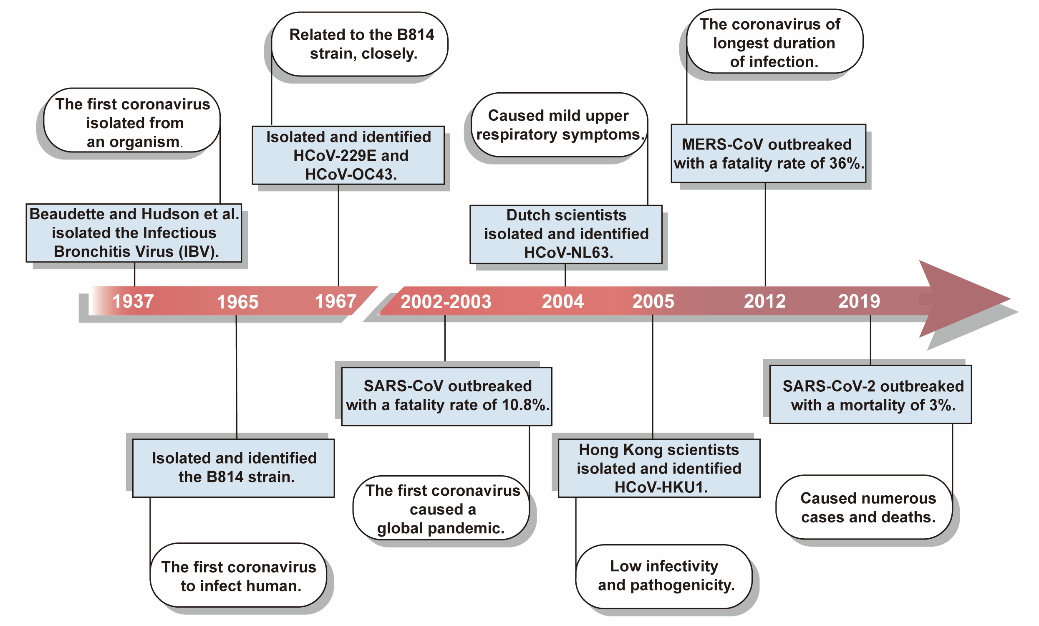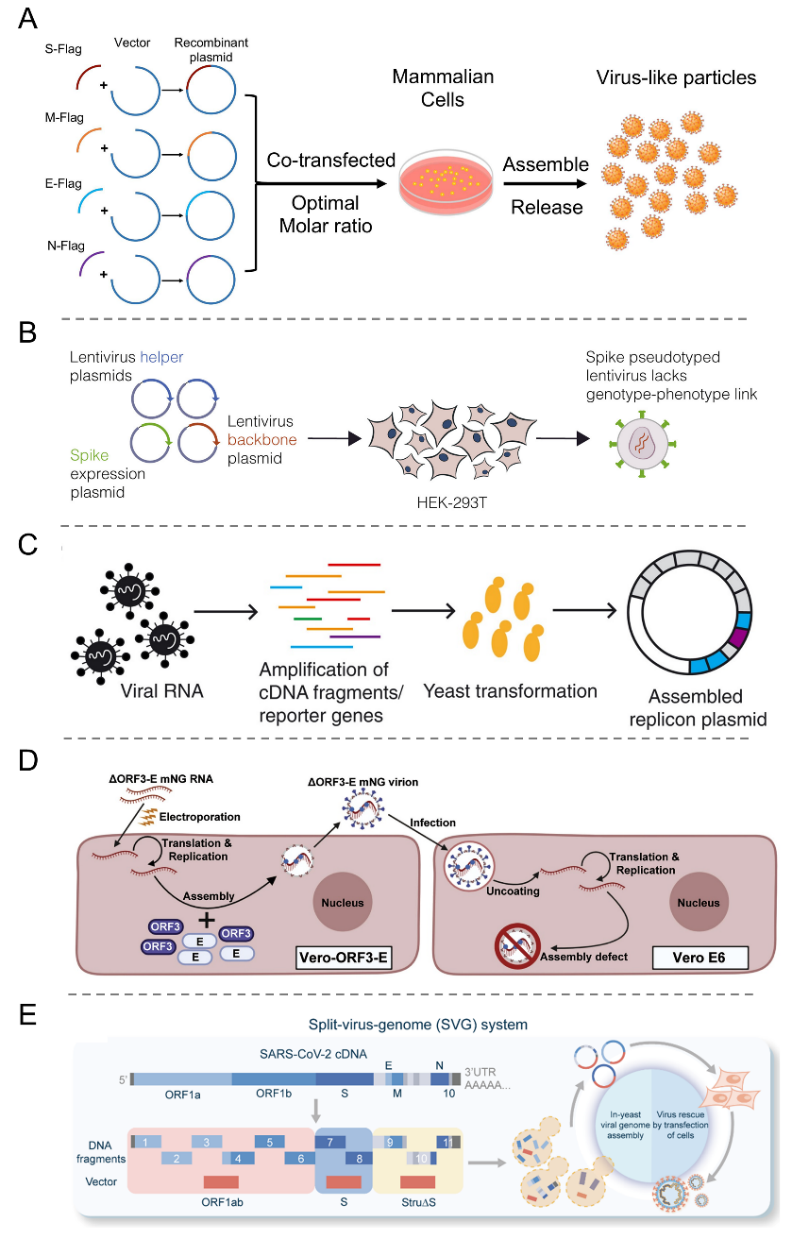
Recently, Researcher Ma Yingxin from the Institute of Synthetic Biology at the SIAT, published a review titled "Design and Application of Biosafety Coronavirus Engineering Systems without Virulence" in the academic journal Viruses.
The article focuses on coronavirus research and summarizes existing biosafety coronavirus engineering systems, detailing their construction methods and applications. These systems integrate virology with synthetic genomics technology to develop effective tools for creating attenuated or non-virulent vaccines, screening antiviral drugs, and studying the pathogenesis mechanisms of novel microorganisms. While discussing the significant convenience these systems bring to the research and treatment of coronavirus, the article also shares the development trends in this area.
Wu Guoqiang, a PhD student co-trained by the Shenzhen Institute of Advanced Technology and the Macau University of Science and Technology, and Li Qiaoyu, a master's student co-trained by the Shenzhen Institute of Advanced Technology and Tianjin University of Science and Technology, are the co-first authors of the paper. Researcher Ma Yingxin and Associate Researcher Mao Guobin from the Shenzhen Institute of Advanced Technology are the co-corresponding authors.
 Screenshot of the article online
Screenshot of the article online
Link: https://www.mdpi.com/1999-4915/16/5/659
Over the past two decades, three deadly zoonotic coronaviruses (CoVs) have emerged: Severe Acute Respiratory Syndrome Coronavirus (SARS-CoV), Middle East Respiratory Syndrome Coronavirus (MERS-CoV), and SARS-CoV-2. The COVID-19 pandemic caused by SARS-CoV-2 has resulted in severe economic and life losses worldwide. Additionally, there are four common low-pathogenic coronaviruses that typically cause varying degrees of respiratory and pneumonia symptoms during transmission: HCoV-229E, HCoV-OC43, HCoV-NL63, and HCoV-HKU1 (as shown in Figure 1).

Figure 1 Timeline of the Coronavirus Outbreak
The damage caused by coronaviruses is irreversible, and it is urgent to conduct a comprehensive research on them. Currently, research related to coronaviruses is conducted in BSL-3 or BSL-4 laboratories, which seriously limits basic virology studies. Engineering virus systems with biosafety allow researchers to study highly infectious viruses in traditional laboratories. The article highlights the methods of constructing viral genomes using synthetic genomics and the construction and application of various engineered coronavirus systems.
Synthetic DNA has been widely used in research, diagnosis, and treatment, among other fields. One of its important applications is the construction of synthetic genomes. De novo synthesis of viral genomes without natural templates is crucial for virology research, providing new technical means for a comprehensive understanding of viral gene functions, expression, and pathogenic mechanisms. Additionally, this technology enables large-scale genetic modification and functional characterization of viral genomes, which is not achievable with traditional molecular biology methods. Reverse genetics is another method based on biological genetic information that involves modifying specific genes or non-coding nucleic acids through targeted gene mutations or insertions/deletions/replacements to study genome structure and function. Moreover, it can be used to develop novel vaccines by directly manipulating RNA viral genomes. The basic construction strategy of reverse genetics includes: (1) obtaining all DNA fragments of the viral genome via RT-PCR or chemical synthesis; (2) assembling these fragments into full-length complementary DNA (cDNA) through targeted RNA recombination, ligation in vitro, transformation-related recombination, or circular polymerase extension reaction (CPER); and (3) transfecting the obtained cDNA into susceptible cells to complete virus rescue (as shown in Figure 2). Synthetic genomics and reverse genetics are extensively used for the de novo synthesis of the entire viral genome, including SARS-CoV, MERS-CoV, and SARS-CoV-2, becoming indispensable tools in virology research.

Figure 2 Common Strategies for the Construction of Reverse Genetics
Additionally, the development of biosafe engineered virus systems is also crucial (as shown in Figure 3). Virus-like particles (VLPs) are hollow particles formed by the self-assembly of one or more viral structural proteins, resembling wild-type viruses and capable of specifically infecting host cells. VLPs display exogenous antigen epitopes at high density, promoting the uptake by antigen-presenting cells, thereby effectively inducing cellular immunity and neutralizing antibody responses. Pseudoviruses are constructed by recombining structural and envelope proteins from different viruses. Common backbone viruses include Human Immunodeficiency Virus (HIV), Vesicular Stomatitis Virus (VSV), and Murine Leukemia Virus (MLV). Another common strategy for enhancing biosafety involves constructing replicons, which are self-replicating subgenomic systems where the gene encoding the viral structural proteins is replaced by a reporter gene. Two other engineered virus systems are the Trans-Complementation System and the Split-Virus-Genome System (SVG), producing genome-defective viruses containing all viral components that mimic the real virus life cycle without generating progeny viruses, used to study protein functions and virus particle assembly.

Figure 3 Construction of Engineered Viral Systems with Biosafety
Biosafe engineered virus systems have been successfully applied in the research of viruses such as SARS-CoV, MERS-CoV, and SARS-CoV-2. These tools have played a significant role in studying virus mutants, preparing neutralizing antibodies, developing vaccines and antiviral drugs, and researching the virus life cycle, enabling the study of highly infectious viruses within BSL-2 laboratories and meeting the urgent needs of virology research. However, due to the large genome size and mutation proneness of coronaviruses, engineered virus systems still face many limitations. With the rapid development of gene editing technology, bioinformatics, and artificial intelligence, precise gene modification, virus structure analysis, and transmission pattern studies have become easier and more efficient. Researchers hope to reduce the infectivity and pathogenicity of virulent viruses through more precise and faster intervention methods, advance the safety research of coronaviruses, and better respond to unknown emerging infectious diseases.
This project was supported by multiple programs such as the National Natural Science Foundation of China, the Ministry of Science and Technology, the Chinese Academy of Sciences, Guangdong Province, Shenzhen City, and the Shenzhen Institute of Synthetic Biology.